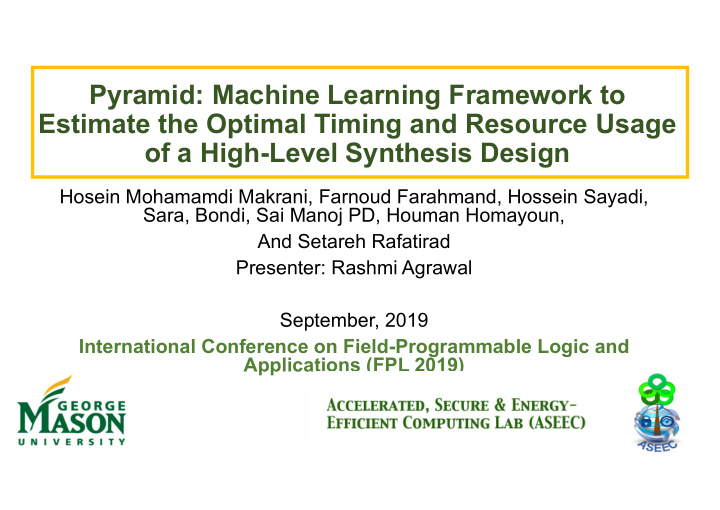



Pyramid: Machine Learning Framework to Estimate the Optimal Timing and Resource Usage of a High-Level Synthesis Design Hosein Mohamamdi Makrani, Farnoud Farahmand, Hossein Sayadi, Sara, Bondi, Sai Manoj PD, Houman Homayoun, And Setareh Rafatirad Presenter: Rashmi Agrawal September, 2019 International Conference on Field-Programmable Logic and Applications (FPL 2019) 1
HLS-Based Development and Benchmarking Flow Reference Implementation in C Manual Modifications (pragmas, tweaks) HLS-ready C code High-Level Synthesis HDL Code Not accurate! Outline: Motivation, Experimental Setup, XPPE, DSE, Conclusion 2
Static Timing Analysis using CAD Tools Logic Synthesis, Technology Mapping, and Place&Route Bitstream Time consuming! Not Optimal! 3
Solution 4
Goal of this Research • We propose Pyramid, a framework that uses ML to accurately estimate the optimal performance and resource utilization of an HLS design • For this purpose: • we first create a database of C-to- FPGA results from a diverse set of benchmarks using Minerva to find maximum clock frequency • We use the database to train an ensemble machine learning model to map the HLS-reported features to the results of Minerva 5
General ML Models ML models: regression model, artificial neural network (ANN), support vector machine (SVM), and random forest (RF) Tuning technique : Grid Search Average Error : LR=23%, ANN=14%, SVM=19%, and RF=15% 6
Ensemble Model Stacking Regression Key Idea : Cross Validation and Batch Training Model Parameters: threshold for the accuracy and the maximum number of iterations 7
Evaluation Results 8
Questions Thank you! 9
Supporting Slides 10
Inaccuracy of HLS Report 11
Challenge of Hardware Evaluation 12
Impact of Optimization on the Outcome of HLS: Average of 10 numbers 13
Using Minerva to Tackle Finding Optimal Results Logic Synthesis, Technology Extremely time Minerva Mapping, and Place&Route consuming! Bitstream F. Farahmand et al., “Minerva: Automated hardware optimization tool,” in ReConFig, 2017. 14
Studied Applications • Benchmarks: Machsuit, S2CBench, CHStone, Rosetta, and xfOpenCV • Development suites: Vivado and Vivado HLS version 2017.2 • Total number of applications: 90 • Applications’ types: Machine learning, Image/Video Processing Cryptography, and Mathematical 15
Data Collection • Total features: 72 • Data set: 60% for training, 20% for Validation, and 20% for testing (unseen data) 16
Recommend
More recommend